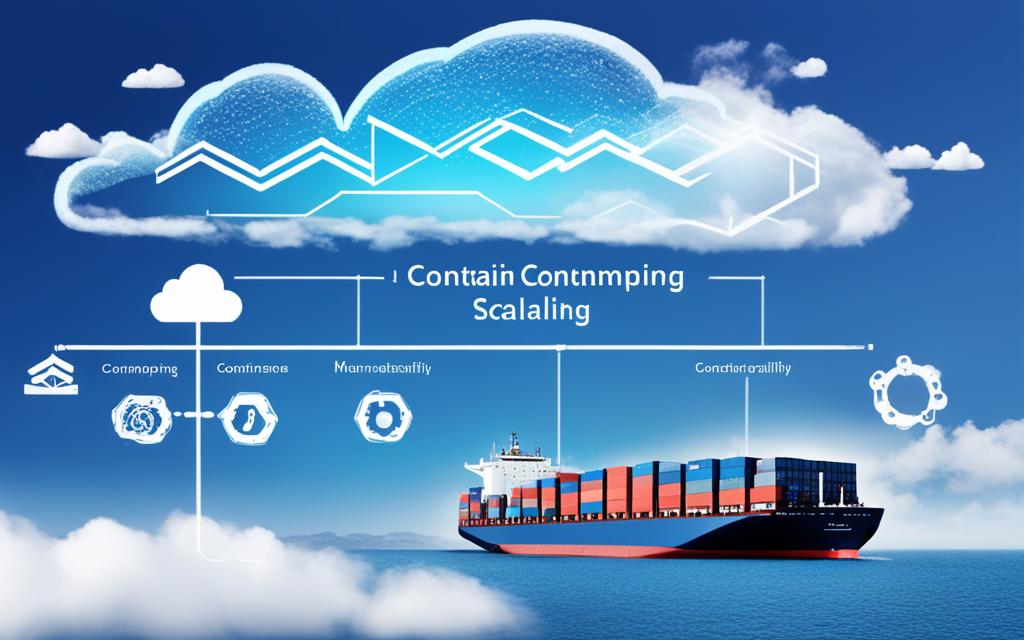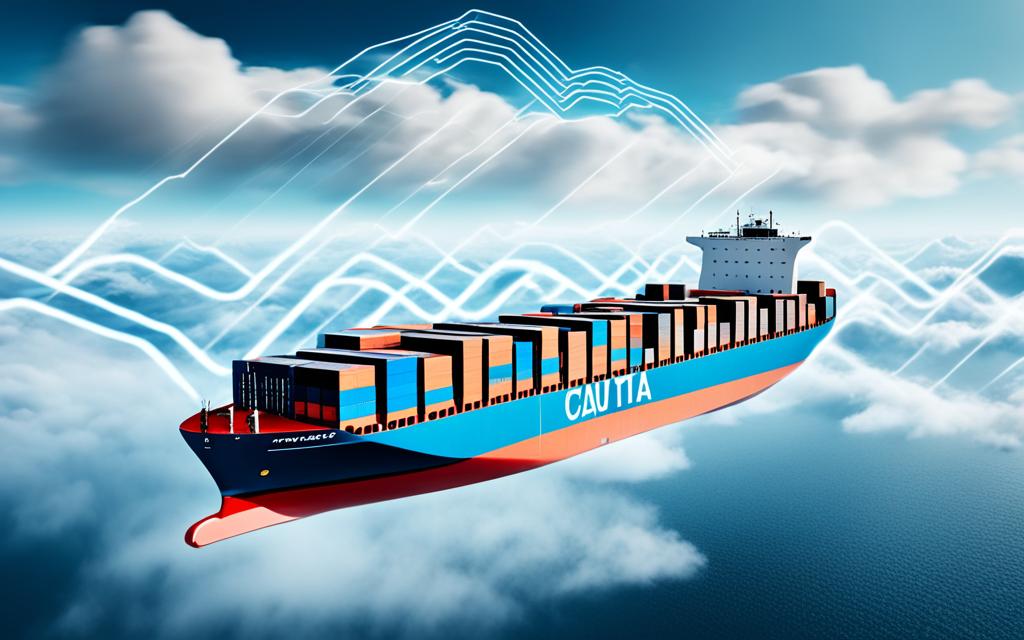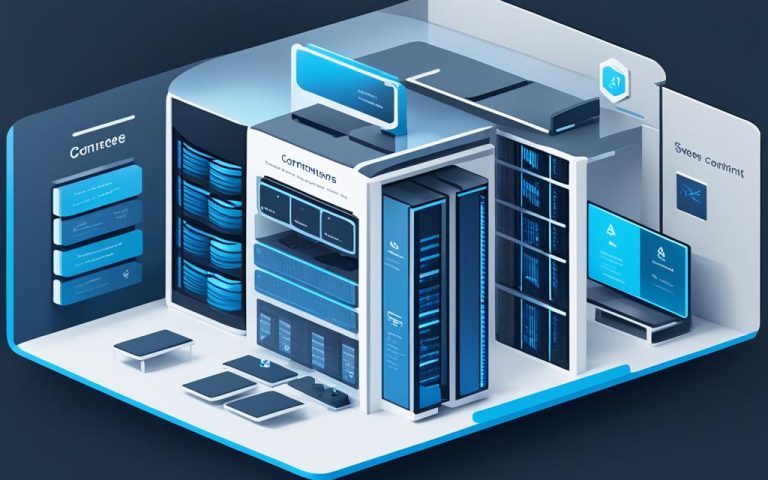Containerization is a revolutionary software deployment process that has transformed the way applications are deployed and managed in the cloud. It offers numerous benefits, including enhanced portability, scalability, fault tolerance, and agility. The combination of containerization and cloud network architecture has paved the way for more flexible and scalable solutions in application development and management.
Containerization allows developers to create a single software package, known as a container, that can run on multiple operating systems and devices. These containers encapsulate an application’s code, dependencies, and configuration files, making it easy to deploy and scale applications across different environments. With containerization, organizations can migrate their applications to the cloud seamlessly and embrace a microservice architecture, where multiple interdependent software components work together to deliver a functional application.
The impact of containerization on cloud network architecture is significant. It provides a more flexible and scalable solution for application deployment and management. Containerized applications operate in isolated user spaces, ensuring that a single faulty container does not affect the others, thus increasing resilience and availability. Additionally, containers can be updated and changed without interfering with the underlying operating system or other application services, enabling faster software release cycles and enhancing agility.
As the adoption of cloud computing continues to grow, containerization will play a crucial role in optimizing cloud network architecture. The combination of containerization and cloud technology allows organizations to build more flexible, scalable, and resilient applications. Embracing containerization in the cloud opens up a world of possibilities for developers and paves the way for the future of application deployment and management.
Benefits of Containerization
Containerization offers several benefits for application development and deployment. One of the key advantages is portability, as containers can run on different operating systems and devices without the need to rewrite the application code. This means that developers can create a single containerized application that can be deployed across various environments, ensuring consistent performance and reducing compatibility issues.
Containers are lightweight and efficient, allowing for easy scalability by deploying multiple containers on a single machine. This enables organizations to optimize resource utilization and handle higher workloads without the need for extensive hardware infrastructure. With containerization, applications can quickly scale up or down as needed, ensuring optimal performance and responsiveness.
Another key benefit of containerization is fault tolerance. Containers run microservices in isolated user spaces, ensuring that if one container fails, it does not impact the overall stability of the application or other containers. This enhances system resilience and availability, enabling uninterrupted service delivery even in the presence of potential failures or errors.
One of the most significant advantages of containerization is agility. Containerized applications can be easily updated and changed without interfering with the underlying operating system or other application services. This means that organizations can deploy new features, bug fixes, and updates quickly, shortening the software release cycles and improving time-to-market. By adopting containerization, teams can embrace iterative development processes, enhance collaboration, and respond swiftly to evolving business needs.
Overall, the benefits of containerization, including portability, scalability, fault tolerance, and agility, make it a compelling choice for modern application development and deployment. By leveraging containerization, organizations can achieve efficient resource utilization, streamline application management, and accelerate software delivery.
Stay tuned for Section 3: Containerization Use Cases, where we explore real-world examples of containerization and its impact on various industries.
Containerization Use Cases
Containerization has become increasingly popular in various use cases within cloud architecture. Below are examples of how containerization is being utilized:
Cloud Migration
One of the prominent use cases for containerization is cloud migration. With containerization, legacy applications can be encapsulated in containers and deployed in a cloud computing environment. This approach allows organizations to modernize their applications without the need to rewrite the entire software code. Containers provide a consistent and portable environment, making it easier to transition from on-premises infrastructure to the cloud. By encapsulating applications in containers, organizations can take advantage of the scalability, flexibility, and availability of cloud infrastructure.
Microservice Architecture
Containerization is also beneficial for adopting a microservice architecture. In a microservice architecture, applications are built as a collection of small, loosely coupled services, each running in its own container. Containerization provides the necessary tools for packaging and deploying these microservices on different platforms. By separating the application into smaller components, organizations can achieve scalability, fault tolerance, and maintainability. Containers ensure that each microservice can be independently developed, tested, and deployed, allowing for more efficient software development and deployment processes.
IoT Device Deployment
Another use case for containerization is deploying and updating applications on IoT devices. As IoT devices often have limited computing resources, containerization simplifies the process of deploying and updating applications across a network of devices. Containers provide a lightweight and efficient way to package and run applications, allowing organizations to optimize resource usage and improve application performance on IoT devices. Additionally, containerization enables easier application management and version control, ensuring seamless updates and maintenance of IoT applications.

| Use Case | Description |
|---|---|
| Cloud Migration | Encapsulating legacy applications in containers for seamless migration to the cloud. |
| Microservice Architecture | Utilizing containers to deploy and manage small, interdependent services in a distributed system. |
| IoT Device Deployment | Deploying and updating applications on resource-constrained IoT devices using containerization. |
How Containerization Works
Containerization is a process that involves the creation and deployment of self-sufficient software packages known as container images. These images contain all the necessary information to run a containerized application, including the application code, dependencies, and configuration files. Containerization tools, based on the Open Container Initiative (OCI) image specification, are used to build these container images.
The containerization architecture consists of different layers, each serving a specific role in the process:
- Infrastructure Layer: This layer represents the hardware on which the containers will run. It includes the physical servers or virtual machines that provide the necessary computing resources.
- Operating System Layer: This layer consists of the operating system on which the containers will be deployed. It provides the necessary environment and resources for the containers to run.
- Container Engine: Also known as the container runtime, the container engine acts as an intermediary agent between the containers and the operating system. It manages the creation, deployment, and execution of containers.
- Application and Dependencies: This layer contains the application code and any dependencies required for the application to run. It includes libraries, frameworks, and other software components that the application relies on.
When a containerized application is deployed, the container engine uses the information in the container image to create a container instance. The container runs in an isolated user space, separate from other containers and the host operating system, providing enhanced security and isolation. The container utilizes the resources allocated to it by the container engine, such as CPU, memory, and network. The application code and other files are included in the topmost layer of the container, allowing the application to be executed within the container environment.
Containerization architecture provides a flexible and scalable solution for application deployment and management. It enables developers to package their applications in a self-contained manner, reducing compatibility issues and simplifying the deployment process. Containers can be easily moved between different environments, allowing for seamless migration and deployment across systems and platforms.
Container Orchestration
Container orchestration is a critical aspect of managing large-scale cloud applications efficiently and effectively. By automating the process of starting, stopping, and managing containers, container orchestration tools facilitate the seamless deployment and operation of containerized applications.
One widely used container orchestration tool is Kubernetes. Kubernetes enables precise scaling and resource allocation, ensuring that containers have the necessary resources from the host platform. With load balancing, service discovery, and auto-scaling features, Kubernetes simplifies the management of containerized applications, particularly as the number of containers grows.
Benefits of Container Orchestration
Container orchestration offers several benefits for organizations that leverage containerization in their cloud applications:
- Efficient resource management: Container orchestration tools optimize resource allocation, ensuring containers have the necessary computing power, memory, and storage to perform at their best.
- Improved scalability: With container orchestration, applications can scale horizontally by adding or removing containers based on demand. This flexibility allows for efficient resource utilization and ensures smooth application performance.
- Enhanced high availability: Container orchestration ensures that containers are distributed across multiple nodes, reducing downtime in the event of failures or maintenance.
- Simplified container lifecycle management: Orchestration tools provide features for automated application deployments, updates, and rollbacks, streamlining the overall container lifecycle management process.
By leveraging container orchestration tools like Kubernetes, developers and operations teams can maximize the benefits of containerization and create robust and scalable cloud applications.
Container Orchestration Comparison Table
| Container Orchestration Tool | Key Features |
|---|---|
| Kubernetes | Automated container deployment, scaling, load balancing, service discovery, and self-healing capabilities |
| Docker Swarm | Simplified cluster management, native Docker support, load balancing, scaling, and integrated container networking |
| Amazon ECS | Managed container orchestration service, integration with AWS ecosystem, auto scaling, and automatic software patching |
| Google Kubernetes Engine (GKE) | Google Cloud’s managed Kubernetes service with built-in scalability, high availability, and automatic updates |
These are just a few examples of popular container orchestration tools available in the market. Each tool offers unique features and capabilities, allowing organizations to choose the one that best suits their specific requirements.
In summary, container orchestration is a critical component of managing containerized applications in large-scale cloud environments. By automating the management process, container orchestration tools like Kubernetes provide the necessary scalability, resource utilization, and fault tolerance for organizations to effectively deploy and manage their containerized applications at scale.
Types of Container Technology
Containerization has gained popularity in recent years due to its ability to enhance application deployment and management. There are several container technologies that developers can choose from, each with its unique features and advantages.
Docker
Docker is one of the most widely used container runtimes. It provides a platform for building, deploying, and testing containerized applications on various operating systems and platforms. Docker allows for the creation of lightweight and portable containers, making it easy to package and distribute applications.
Linux Containers
Linux provides its own container technology, known as Linux Containers (LXC). LXC enables the creation of self-contained environments, allowing multiple Linux-based applications to run on a single host machine. It provides resource isolation and simplifies the deployment of applications.
Kubernetes
Kubernetes is an open-source container orchestrator used for deploying, scaling, and managing containerized applications. It offers a declarative model, allowing developers to define the desired state of their applications through configuration files. Kubernetes simplifies the automation and management of containers in large-scale environments.
These container technologies offer flexibility and efficiency in deploying and managing applications. Developers can choose the most suitable container technology based on their specific requirements and the nature of their applications.
Conclusion
Containerization has revolutionized cloud network architecture, bringing about a paradigm shift in the deployment and management of applications. The adoption of containerization in the cloud offers a multitude of advantages, including enhanced portability, scalability, fault tolerance, and agility.
By encapsulating applications and their dependencies into containers, organizations can achieve greater flexibility in deploying and scaling their applications. Containers allow for the efficient utilization of hardware resources, reducing costs and improving overall performance. Furthermore, the isolation provided by containerization ensures that faults in one container do not affect the entire system, enhancing fault tolerance and availability.
Container orchestration platforms, such as Kubernetes, further amplify the benefits of containerization by automating container management on a large scale. These tools enable precise scaling, load balancing, and resource allocation, simplifying the management of containerized applications in cloud environments.
As cloud adoption continues to soar, containerization will play a vital role in optimizing cloud network architecture. It empowers organizations to build highly flexible, scalable, and resilient cloud applications. By embracing containerization and adopting a microservices architecture, businesses can leverage the full potential of the cloud, driving innovation and achieving operational excellence.
FAQ
What is containerization?
Containerization is a software deployment process that allows developers to create a single software package, called a container, which can run on multiple operating systems and devices.
What are the benefits of containerization?
Containerization offers several advantages, including portability, scalability, fault tolerance, and agility. It allows for easy deployment and scalability of applications, operates in isolated user spaces to increase resilience, and enables updates and changes without interfering with other services.
What are the use cases for containerization?
Containerization is widely used for cloud migration, adopting a microservice architecture, and deploying and updating applications on IoT devices. It simplifies the process of encapsulating legacy applications, utilizing multiple interdependent software components, and deploying applications across limited computing resources.
How does containerization work?
Containerization involves bundling an application’s code and dependencies into a container. Containerization tools, based on the Open Container Initiative image specification, are used to build container images. These images contain all the necessary information to run a containerized application.
What is container orchestration?
Container orchestration is the automatic management of containers, particularly in large-scale cloud applications. Container orchestration tools, such as Kubernetes, automate the starting, stopping, and management of containers, providing features like load balancing and auto-scaling.
What are the types of container technology?
Some popular container technologies include Docker, a container runtime used for building, deploying, and testing containerized applications; Linux, which provides self-contained environments for running multiple Linux-based applications on a single machine; and Kubernetes, an open-source container orchestrator used for deploying and managing microservices.




















One Comment